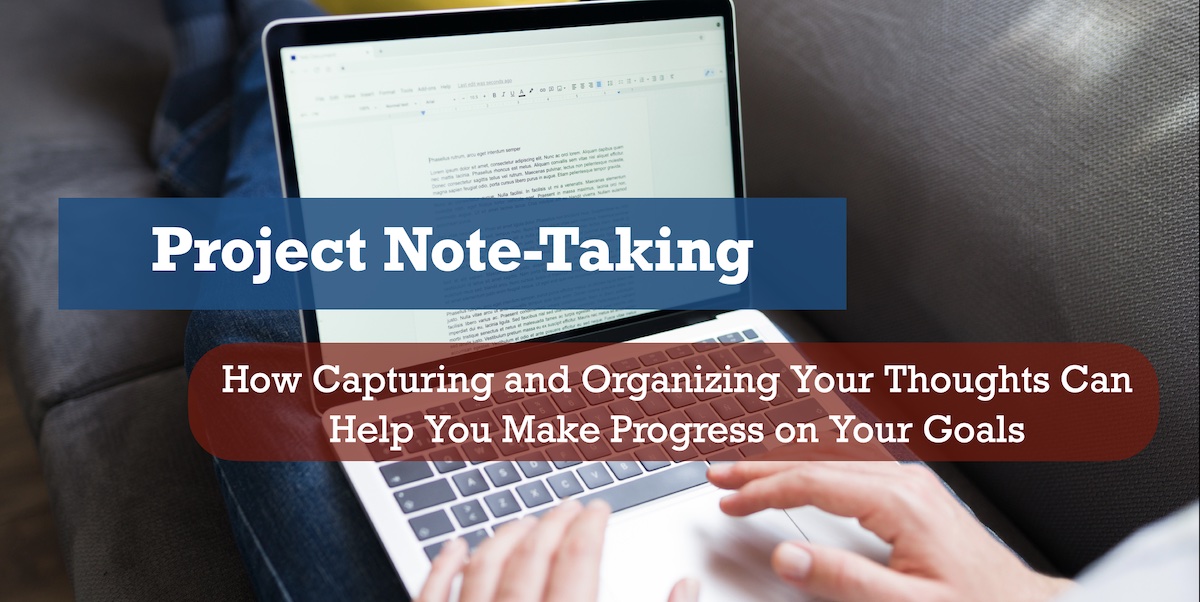Project note-taking is one of the simplest yet most powerful techniques I use to capture ideas, reflect and make progress on all of my goals. Project notes are a diary tailored for each step in the journey.
Whether I’m pursuing a professional project, setting a personal goal, or embarking on a new learning path, project Notes are a process and progress journal I keep digitally for each and everything I work on. This simple document includes action items, key links, and, most importantly, a reverse chronological log that captures the essence of my progress and reflections.
Much like a personal diary, my project notes is open-ended and flexible. You can use it to reflect and journal on a goal. Before you send (or not send at all), you can draft important emails, like an email to a boss, new customer or prospective client. You can start some early thoughts on strategy, initiatives or some step in a work project, like new marketing or product initiative. When facing many paths and uncertainty, an entry could be a way to nudge you to define what you should focus and work on next. When you have some success, it can be a path to write a note of celebration. Similarly it can be a place to recognize failure, accept defeat and process it.
Project note-taking emerged as part of my own productivity and organizational practices nearly a decade ago along with task management, task tracking and weekly reviews. Instead of a physical notebook or separate notes scattered across local docs and online tools, I created a single project note for any project or goal with multiple steps and aspects to document and reflect on. I have used separate project notes to track and manage my health and exercise, write and publish, navigate my career, manage different tech, design and marketing projects for clients, learn, and pursue creative goals.
To share one specific example, I started a project note called Learn Music Studies in April 2020. At the time it was just a fun hobby during lockdown for COVID-19. In that doc, I journaled and documented my early music production studies, writing and producing my first songs, buying gear, and deciding and learning new skills. As my learning path evolved, skills improved and ambitions changed, I set a new goal: make an album. I then started a new project note for my artist and album project called Stellar Mammals.
The first doc supported and covered most of My Personal Music Production Learning Journey while the Stellar Mammals Project Note enabled me throughout the iterative, reflective, up-and-down emotional journey releasing my first, second and third albums. I likely could have achieved these goals without having a project note but I personally find it indispensable now.
Frank, I’m advice: Just take notes! For pursuit of learning or a goal, taking notes and journaling are positive and enabling in and of themselves.
Project notes are a bit more special and designed to enable a longer-term reflection-feedback-action process built on intentionality, review, act. By keeping a log of on-going notes, storing early drafts of deliverables, capturing feedback and ideas, and reflecting over time, project note-noting has helped me:
- Talk It Out First: Project note-taking are a stop-gap with myself to pause and talk out loud (at least to myself) what I’m thinking, before I send that email, draft that doc or act on a project or goal. I could easily write that email in Gmail or draft that proposal in Notion or Google Docs, but having a separate and private place to start the draft forces me to verbalize my thoughts, emotions and back-and-forth first to myself before I share with others. Sometimes this means not sending the email, working more on the first drafts or clarifying what matters and how to get there.
- Sharpen My Focus: With all of the key information on a project or goal in one place, it’s easier to see what I’m doing, prioritize and zero in on what truly matters.
- Overcome Obstacles: Documenting challenges (and your solutions to them) creates a roadmap for future hurdles, both tangible and emotional.
- Reflect Before Action: Once I upon a time I was obsessed with productivity in and of itself. I’ve evolved to see reflection as critical to next level productive. Writing encourages contemplation and introspection. Before rushing into decisions or purposeless action, project notes allow you to weigh pros and cons and stay objective and meaningful in how I act (even if it’s just an email to a colleague).
- Own Your Obstacles: If you are a creative or working professional, there is a good chance your work is nonlinear, ill-defined and frankly challenging. Your project notes allow you to identify priorities and address obstacles (both practical and emotional ones). By owning them, defining them and thinking through them can help you creatively get through them.
- Track and Celebrate Progress: I have dedicated a lot of my writing to self-tracking and personal data with the hope that I could cultivate greater self-knowledge and self-awareness. I’ve come to see one of the main benefits is a honestly recognition of progress and how far you’ve come. My project log is a good tool to look back at past entries and to propel future actions.
In essence, project note-taking is an enabler of reflective intentionality. It encourages deliberate actions, nudges you to notice, note and prioritize, fosters self-awareness, and propels meaningful productivity.
By taking the time to create and use project notes, anyone can significantly improve how they think about, reflect and act on their projects and goals. This can empower you to make meaningful, incremental progress, and, by extension, increase your productivity too.
In this blog post, I want to share how I use project note-taking as part of my own reflective productivity and goal pursuit processes. We will look at what is a project/goal, the basics of a project note, their benefits and some practical tips. Hopefully by the end you’ll be equipped to try this in your own life to capture, manage and reflect on whatever epic goal you are pursuing.
What is a project?
The New Oxford American English dictionary defines the word “project” as “an individual or collaborative enterprise that is carefully planned and designed to achieve a particular aim.” While this is a decent working definition, productivity “Guru” and creator of the Getting Things Done methodology David Allen gets right to the heart of what I project is, namely:
“A project is anything involving multiple steps.” - David Allen
A project is any initiative that has more than one step or task to complete it.
So really everything is a project, including most goals, studies and endeavors.
Projects can vary widely in scope and complexity. It can include small personal tasks like organizing a closet or planning a vacation to large-scale business objectives like building a new product or launching a marketing campaign. Projects can be pursued individually or collectively. Project management is a huge topic, much like two topics I’ve written extensively on, task management and productivity.
Regardless of the size or nature of the project, effective project management is an incremental, step-by-step process. It requires careful planning, communication, and coordination to ensure that the project is completed successfully and ideally on time and within budget.
In short, a “project” is a multi-step endeavor with a target goal or aim. Some might be specific, short-term and straightforward. It might be obvious what you steps you have to do to complete. Most are projects are complex, nonlinear, long-term, and involve unknown and unspecified requirements. Most projects need to be iterated on, demand a degree of reflection, and take incremental efforts and progress to be complete.
Like all effective goal-setting, projects should have a defined goal or outcome you want to get to, and in most cases a project shouldn’t require more than 12 months to finish. Ideally a project goal should be in an even more reasonable and achievable time period, like a few weeks to a few months. If a goal you set is going to take years, then you should create a more proximal or near-term project goal.
When it comes to the science of goals, productivity and achieving what you care about, completing projects is largely what we should aim and optimize our efforts towards. Completing projects is a huge driver of learning and progress-making. If you complete a project, there is a strong chance it will advance you towards the biggest goals that matter in your work, your life and your legacy.
Now that we’ve defined what is a project or project goal, let’s turn to how I stumbled into project notes and some productivity practices.
From Chaos to Clarity: Birth of Project Note-Taking and My Productivity Processes
A bit over a decade ago I was pivoting into software development and tech product consulting. I was able to complete projects and make progress, but there was a lot of stress, disorganization and frankly lack of productivity. I lacked tools to help me stay organized, manage my tasks and projects and most importantly manage my time and focus.
During that time at a startup meetup I was recommended “Getting Things Done” by David Allen. His book and “Getting Things Done” (GTD) methodology proposed various principles and steps to handling information overload. His aim was turning all of that “stuff” (i.e. messy information and unclarified “work” demands) into something manageable and actionable.
A dive into GTD goes beyond this post. You can read my review and overview in Getting Things Done with Todoist.
Practically speaking, GTD lead me to:
- Manage My Tasks using a Task Manager
- Manage Time-based Appointments and Deadlines using My Calendar
- Schedule and Track My Time using RescueTime and Toggle
- Do Weekly Reviews
Interestingly it was around this time, that I started to doing what would become my project notes.
While I didn’t formally have a name for it, I started taking notes in a single doc for what I was learning and consulting projects I was proposing or engaged on as a software developer and project manager. I would come to cover my own startup projects, volunteering and my jobs at different companies.
Built on aspects of GTD, initially my focus was on having three main components for project management in one place:
- Next Action Items List
- Key links to resources
- Log of Notes
Basically I was looking for a single note for me to take notes, store key action items ahead and link to important docs, resources, etc. When you are juggling a lot of projects as I was then and continue to do today, it can be tricky and mentally taxing to try and store it all in your head. Your head is not where you should store your tasks and project notes. You need to tools to capture information, make it easy to see and prioritize and simply get to work.
Initially my main tool was Evernote. Evernote took on many hats for me including even a period at my task or todoist tool. Even after migrating my learning notes to The Archive and plaintext, I continued to do much of my project note-taking in Evernote, especially since it was so easy to do search.
Over time project notes emerged into a slightly more formalized and organized component of my general note taking and knowledge management system which I describe later in this post.
Productivity is an expansive topic and sadly many of us (myself included) can get stuck in a rabbit hole exploring systems, productivity “hacks” and nifty tools. There is no one-size-fit-all approach, instead I recommend finding and sticking with reliable and easy to use tools to task manage, knowledge and note-taking and time tracking. Beyond that, schedule time for regular reviews and iterate.
Personally I think project notes are an underrated opportunity for creatives and working professionals to get many of the benefits of structured journaling and reflection in way that makes you a better do-er too.
What is a Project Note?
A project note is a single document to help you capture, prioritize, plan and take notes on a project or goal. It serves as a centralized repository of information related to a particular project or initiative.
A project note typically includes three areas:
- Next most important action items
- Quick links to relevant resources or deliverables
- Log of notes, drafts and reflections (in reverse chronological order so latest notes are at the top and oldest at the bottom)
Project notes can be created in a variety of formats, including plaintext files (my preference) or in your favorite note-taking tools like Notion, Google Docs, Apple Notes, etc.
The main purpose of project notes is to help you stay organized and focused on your goals, while also providing a record of your progress, thinking and decision-making process over time. If
The structure of my project notes is pretty simple:
- Title: At the top there is the main title of the project
- References: Next I’ll put a few key links to either external websites, project management tool, project files (for design), dashboards or cross-linked to other project notes.
- Next Action Items: Below that is a checklist section called “Next Action Items.” This is where I list important next steps on a project initiative.
- Notes and Log: Finally there is a section I called “Notes and Log” or “Progress Notes.” This is a kind of process journal where I take notes, draft an email or google doc, record my progress and reflect.
I try to keep my next action list to under 10-15 items, ideally just 5 or 6. If there are more, I prioritize and break them up into a separate section like “Later” or “Skip for now.” Ideally this list serves as an immediate jumping off point for working on a project. I can be used alongside your task management tool, like Todoist.
The core component and use case for my project notes are the reverse chronological “Notes” or Log. It is at the heart of project note-taking. It functions much like a diary or multi-entry journal. At the top is my latest entry. The subsequent entries are in reverse chronological order and follow a similar format. For each entry, I put a title and the datetime when I started and/or updated the entry. It becomes easy to scan from top to bottom to review past work, previous reflections and stored feedback.
Let’s look a few examples and template, before exploring in more detail what I write for typical project note entries.
Project Note Examples
If a project is simply any multi-step or multi-task endeavors, then nearly everything becomes amendable to having and leveraging project notes.
I currently have several hundred projects with project notes. Each project note is intended to be quite specific and singularly focused. Even though they can cover short one-off projects, longer-term initiates, learning and a range of other goals, what are some of my own project notes?
Here’s a list of a few randomly selected examples:
- 201610262346_Blood_Pressure_Log_Monitor_and_Tracking_Marks_Notes
- 201911270831_Learn_React_Javascript_Log
- 201603041527_CYCLING_Biking_Log
- 201804101732_Statistics_and_Probability_Studies_Log.md
- 201912201036_[Startup Name]_Log.md
- 202101102114_Video_Creation_Log
- 202004231141_Learn_Music_Studies_Log
- 202006261842_Hindi_Studies_Log
- 202007271031_[Client Name]_Development_Client_Log
What this truncated list hopefully indicates is that the possibilities for project notes is pretty endless. In my own case, I find it can probably be broken down in a few types. Let’s look at a few more examples accordingly:
Health and Exercise: Project Note Example
201608111933_Maximum_HR_Heart_Rate_Log&Test_Results:
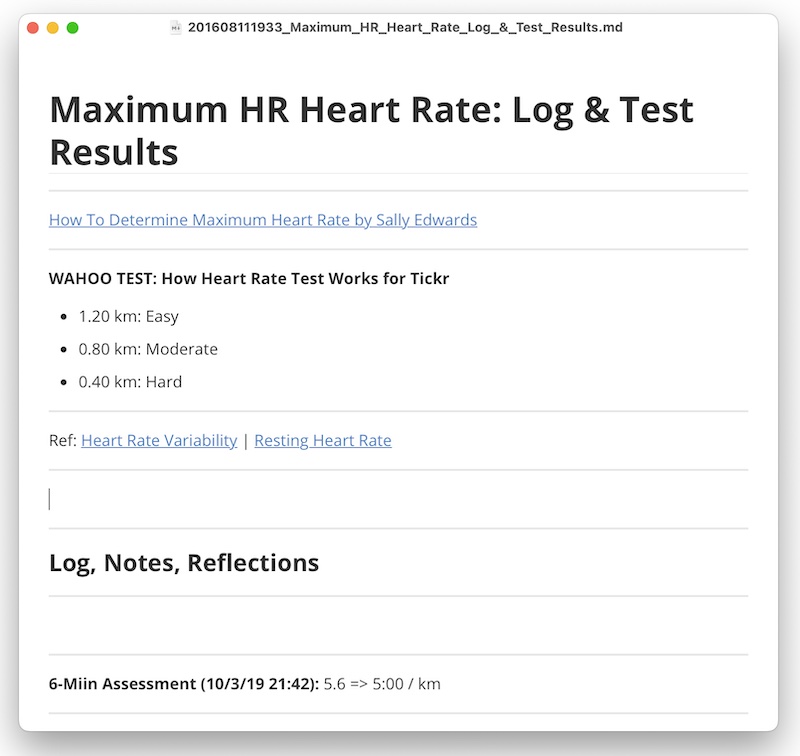
I have a host of notes covering specific biomarkers. It’s good to track various numbers in a spreadsheet or dedicated app. By contrast a health project note gives you more of a space for reflection and learning.
201612181203_On_RUNNING_Running_Log:
I started running several years ago and there have been quite a few up’s and down’s. While I have written a lot about my journey to start running, training for marathons and learning along the way, I am now starting to see how my running log or running project notes have been a persistent support mechanism in this journey too. From vetting frustration to articulating next steps to tracking the progress, these notes helped.
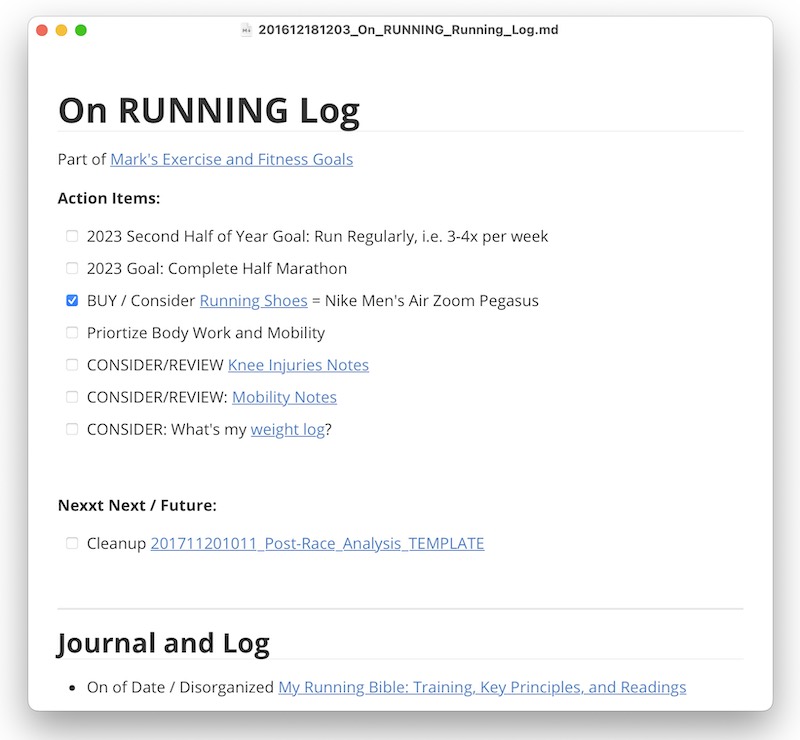
Check out my blog post series on running covering data-driven training and books on running too.
Learning and Personal Studies: Project Note Example
I have dozens of project notes to different topics I’ve explored, studied and in some cases mastered.
201709111855_R_Language_Programming_Studies_Log:
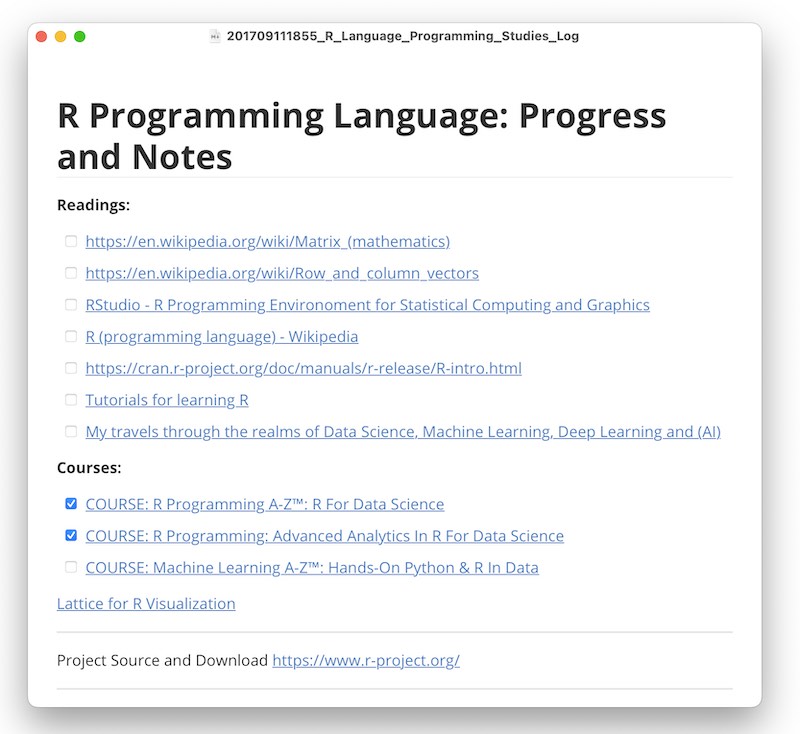
202004231141_Learn_Music_Studies_Log:
Learning music production has been a fun and meaningful hobby that I have now cultivated in a semi-professional. Here is the latest snapshot with links to related projects, key next actions (always changing), and a couple entries.
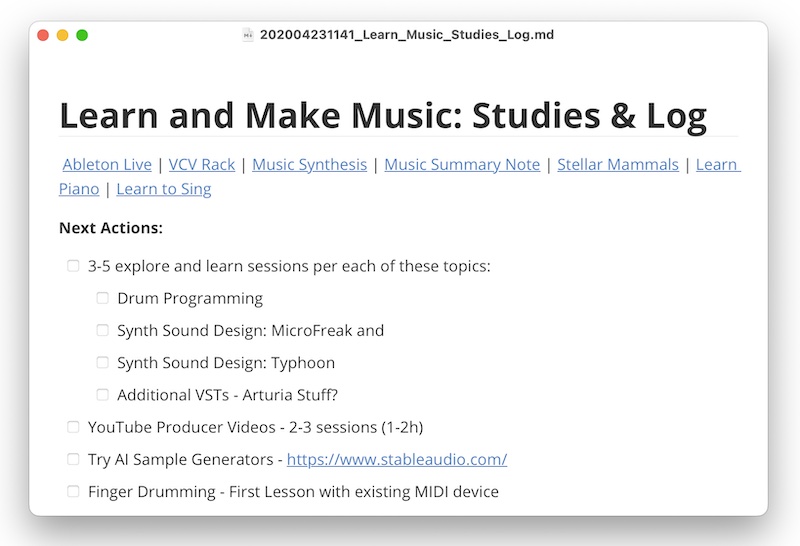
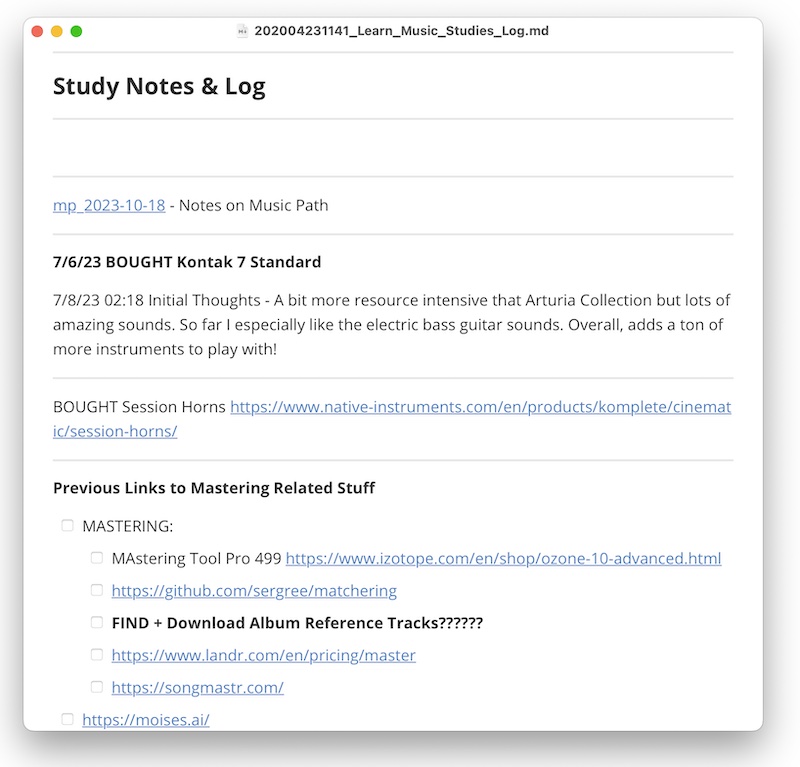
You can read more about my music and music learning process in my on-going series on Goals and Music Production.
What do I do, write or put in a project note entry?
In today’s fast-paced world, immediacy is often mistaken for efficiency. While swift responses have their merit, they might not always be the best course of action. A small pause, facilitated by first writing a note or email in your project notes log can often lead to better communication and ideally better outcomes too. But how might you use or what might you write about in these individual entries?
The gist of it is that all of my projects get a project note where I record various notes that help me work and think better. The core of it is a reverse chronological log of individual entries. This serves as the central space for all the intricate details of a goal’s or project’s journey. Each entry acts as a process journal, capturing my thoughts, plans, and reflections.
Here are a few ways I write my individual entries:
- Drafting Space: Before I pen down an email or put words a Google doc, I often draft them here first in a project note.
- Progress Tracking: Whether it’s a note from others or a note to myself, it’s good to externalize progress and track it over time. These notes serve as a way to state what is happening and enables me to keep a finger on the pulse of my project’s progress, both good and bad.
- Capturing Email Responses and Feedback: A lot of work happens over email and chat messages. Some of these messages I copy and paste into my log for reference and storage. This is a particularly powerful habit since it allows you to see more of a project’s journey from how colleagues and collaborators pushed on it. Oftentimes I’ll paste in the key parts of an email from someone else and draft a response in the project note.
- Clarifying Goals and Status: I often don’t know what to focus on or even what is the next step so I’ll use a note to try and externalize my goals and planning, i.e. think before you act.
- First Pass Check-in and Review: A certain percentage of my work involves reviewing progress, checking data, etc. I may need to send out a formal email or draft a report or presentation. But before I do that, it can be useful to do more light touch data capture and review. This might just a bulleted list of data points and takeaways.
- Ventilation Space: Not all drafts can and should turn into emails or messages. Sometimes, the act of writing serves as a ventilation tool, helping me understand my emotions, my initial reactions and approach situations with a clearer mindset. The simple fact that I start writing in my project journal means I’ve put in a bit more pause before it goes out and without an undo.
- Celebrate Achievements and Successes: In an ideal world, I’d get celebratory messages from clients and colleagues but sadly this is rarely the case. In order to notice and celebrate a project’s achievements, I write it in my logs. This always seems to do a great job of giving me a little boost and the log itself can remind of how far we’ve come, even if no one else says it.
Beyond the main idea covered in each entry, it’s important to be consistent. Each entry should be formatted uniformly with a descriptive title and a timestamp, detailing when the entry was started and last updated. You should have obvious visual breaks or lines between entries to aid scanability.
In terms of tone and voice, that’s entirely up to you. Personally, I like a “diary-esque” approach that is fluid yet organized.
Much like a sea captain’s log (or what I imagine one is like), my project notes strive to contain a daily or regular work log, saved work expressions (emails, ppt slide text, notable design artifacts, marketing copy, etc.) and different reflections over time. Writing helps clarify thinking. Pausing before sending avoid emotional overspills or misperceived overreactions too.
Benefits of Project Note-Taking
I find having a project note helps me “talk to myself” about the work in a way that empowers me. For example, it helps me get started on certain harder tasks or gives me a little bit of distance between drafting an email and sending it (or sometimes not sending it).
There a wide range of benefits to project notes and project note-taking. Here are a few that are top of mind for me:
Certainly! Based on our discussion, here are the benefits of project notes and the practice of project note-taking:
- Better Organization: Maintaining a structured and comprehensive record with elements like action items, key links, and progress logs helps in keeping everything related to the project organized. It fits well and complements different productivity systems and tools as well.
- Clear Direction and Focus: By outlining and owning an project or goal-related objective or sub-goal at the outset and in writing, project notes provide a clear sense of direction. A stated purpose ensures all actions align with the end goal, and your long-term ambitions are met with short-term focus.
- Enhanced Reflection and Learning: For long time I saw project notes as primarily a tool for productivity and organization. Over time, I see one of its main benefits as facilitating self-awareness through captured reflective or introspective moment. In fact, the process journal aspect of the notes allows for continuous reflection, helping to identify what I’m doing (or intended to do), areas of improvement, and lessons learned. Greater reflection leads to great productivity.
- Improved Communication: Drafting emails or responses in a private note before finalizing them ensures that the communication is thought through. It makes me a better communicator since it inserts a few moments to review, even during copying and pasting. This enables me to reduce chances of miscommunication or sending reactive responses.
- Emotional Regulation: There are a times when I get emotional. The space to draft and reflect provides a buffer against immediate emotional reactions and provides time to consider if I understood the situation fully and am responding approaching. I believe this help me deliver more balanced and measured responses in personal and professional scenarios.
- Documentation: I love having simple docs that explain the evolution and thinking behind a project or goal. Storing feedback, tracking challenges and solutions, and recording key decisions ensure that there’s a documented history for the lifecycle of any project or goal. Even if I take a pause on a goal, I can easily return to my project note to see where I left off and reflect on what might be next. It’s invaluable for future reference and iterative reflective doings.
- Facilitates Thoughtful Decision Making: For me, the act of journaling, writing and reflecting before taking action is a big part of my reflective productive process. I believe it encourages me to consider choices, weigh pro’s and con’s and make informed, intentional choices.
- Productivity Boost: By consolidating all thoughts, plans, and resources in one place, project notes help reduce cognitive load. I don’t have to guess or search. I have a single doc with priorities and documented steps, allowing for a sharper focus on tasks at hand or questions ahead.
- Aids in Prioritization: With all information and progress updates available in one place, I can quickly identify and prioritize the most crucial tasks or issues. When notes get out of hand and next actions goes beyond 5 to 10, I visually see it and can break it up, drop what doesn’t mater and focused on what does.
- Enhances Accountability: Simply writing a note on a project enhances your ability to see if you have been making progress. By logging actions, progress and challenges, project notes can serve as a tool for self-accountability, ensuring that one stays on track and addresses any obstacles.
In short, project note-taking is a comprehensive and complementary approach that provides both tangible and intangible benefits for any thinker, learner or do-er. It can act as a singular source to talk about, prioritize and reflect on any goal or project you have. The structured approach can enhance project management, emotional intelligence, and overall productivity too.
[Bonus Aside] Summary Overview of How I Take Notes (Oct 2023)
As project notes fit in my larger “second brain” system. Let me share a few high-level ideas (with links) on my note-taking, knowledge management and writing system.
For nearly all of my notes and writings, I write and save in plaintext. Plaintext files are flexible, portable (can be opened on basically any text editor), future-proof and there are a lot of good tools nowadays. While I previously used Evernote and would be interested in Notion/Obsidian for note-taking, my two current preferred plaintext markdown editors are The Archive and Typora.
As I wrote in Plain Text Life, which had a good overview of my general system, the point is that “this setup helps me focus on what matters: writing and keeping my projects, ideas and thinking organized and interconnected.”
I divide note-taking into a few different buckets:
- Smart notes are key ideas I learn, discover or take notes on. Learn how it relates to knowledge management or how it fits in a Plain Text Life
- Writing drafts covers any stage from simple idea to ideation to research and finally drafting, writing, editing publishing. I use simple tags to keep it organized and crosslink to related smart notes, much like a personal Wiki.
- Journaling is one of the most active components of my writing life. Read more in Journaling for Self-Trackers and Quantified Self Enthusiasts or AI as a Journaling Companion
- Project notes [This post]
- Weekly Reviews are important form of tracking, accountability and personal reflection I do each week. It’s similar to goal-specific check-in’s and how I manage my studies too. For a deeper dive, check out The Data-Driven Weekly Review: How to Use Data and Self-Reflection for Iterative Improvements or check out my simple goal tracking and scoring approach.
Combined these form a pretty comprehensive system for taking notes, reflecting and writing (which is the main output goal).
I use a simple file naming convention, tags and some basic directories to keep files organized and easy to find. Files are in this format: Timestamp + keyword/topic + [log, note, summary]. For example, 201610262346_Blood_Pressure_Log_Monitor_and_Tracking_Marks_Notes.md or 202006261842_Hindi_Studies_Log.
Additionally, I use git version control to store any textual changes I make. As I explain in Tracking My Writings this allows me to track any and all changes I make on a project or piece of writing over time. I still haven’t taken full advantage of tracking notes, but I hypothesize I’ll be able to glean personal insights and various trends one day soon.
Whether it’s an important idea that interests me; a project, goal or area of study; or drafts and completed writings, it’s super simple for me to find and immediately jump into any of my markdown notes in a couple keystrokes. In each file whether it’s a smart note, journal entry or project note, I’ll see latest and most important updates at the top and links and tags to connect related parts. It’s all there and interconnected.
When collaborating, I’ll of course use a shared, real-time document, but for local journaling, initial note-taking, planning and writing I love my plaintext life. In the future, I’m also keen to see how I’ll integrate it with AI and LLMs like ChatGPT.
Tips for getting the most from your project notes
There is no right or wrong way to take project notes. I’m a fan of start with a few elements that resonated with you from what I do or what you think might work and trying it. Then iterate and changes as it fits your needs and your goals.
Here are a few tips to enhance your project note-taking:
- Keep your project notes up-to-date: Make sure you take a moment from time to time update your project notes regularly so that they reflect the latest information about your projects and your thinking on them. Your notes don’t need to be a perfect record of everything but they should strive to capture the important stuff over time. Don’t stress if you forget for awhile. Just start with a general update note to yourself.
- Use a consistent format: Develop a consistent format for your project notes, including a clear title, next action items, and notes and log section. This can make it easier to find information when you need it.
- Prioritize next action items: One of my biggest productivity lessons was learning to turn vague projects into specific action items. Make sure to define what you need to do and prioritize what’s next. Focusing and making progress on the most important tasks first can be a huge productivity boost and motivator too. This can also help you make progress on your projects and prevent you from feeling overwhelmed.
- Review your project notes regularly: Set aside time to review your project or goal. Put your thinking and review in its relevant project note. I personally like to schedule check-in’s for certain projects and goals, such as at the beginning or end of each day or week or in the case of my learnings every 6 weeks. Regular check-in’s can help you stay focused on your goals and ensure that you’re making progress.
- Use tools that work for you: Experiment with different tools for taking project notes, such as plain text files, note-taking apps, or project management software. Choose the tools that work best for you and your workflow. While I’m a fan of developer-centered plaintext editors, it’s fine to use whatever tool you like and fits your needs.
- Reflect on you, your goal and your progress: Reflection is the secret ingredient and one of the chief benefits associated with project note-taking. Use your project notes as a tool for reflection, reviewing your progress regularly and making adjustments as needed. Ask yourself regular if you have defined an appropriate next step or project. Don’t be afraid to challenge your previous focus and pivot into what you care most about and what will move you forward. Goal and project pursuit is an iterative process. Reflection can help you find your pathway forward.
Conclusion: Capturing and Thinking Twice through Taking Project Notes
A journey of a thousand miles starts with a single step. - Confucius
Project notes serve as my compass and map on this journey. They help me:
- Maintain productivity
- Chronicle significant moments in my daily work
- Gain insights into my professional and personal evolution
- Cultivate clearer thoughts
- Foster emotional and intellectual well-being, i.e. feel better
Projects are often framed in terms of utilitarian outcomes and objectives you want to achieve, yet the path to reaching these goals is seldom straightforward. Most projects and goals grapple with uncertainty and demand continuous learning and adaptation along the way.
This post explored the concept of project note-taking—a method of taking semi-structured notes to document progress on any project or goal. At its core, project notes are individualized logs, each dedicated to a specific project. They provide quick access to relevant links, key action items, and a reverse chronological account of diary-like entries. These entries, for me, include project check-ins, updates, reflections on decisions or future actions, and saved feedback and messages from collaborators.
Project notes are my go-to tool for fostering clear thought processes, organizing my journey, and ultimately, making progress. They serve as a single repository for all essential project elements—facilitating a streamlined workflow and ensuring a calm, measured approach to communication and decision-making. In essence, they are the cornerstone of my productivity and personal growth.
By establishing a designated space for storing and regularly documenting both intentions and reflections, you heighten your self-awareness regarding your project or goal, as well as your personal connection to the work, decision-making process, and overall journey.
This practice has transformed me into what I consider a “reflective practitioner,” equipped to manage various projects and their intricate components. It extends beyond mere execution and doing; it’s an opportunity to contemplate the acts and activities that truly drive meaningful outcomes and outputs. Occasionally, the epiphanies I uncover while journaling about a project lead me to step back, disengage, or redefine the project’s goal.
The beauty of project note-taking lies in its flexibility and openness to experimentation. Over time, I have not only heightened my productivity but also experienced personal growth—often facilitated by moments of reflection, introspection, and self-discovery, rather than simply working harder or longer.
Best wishes and happy note-taking!
AIDA (AI Disclosure Acknowledgement): The following written content was written by me with the assistance of an AI-based system (ChatGPT). Specifically I used it to help me in some aspects of the pre-writing phase (outlining), drafting a few individual points, and clarification improvements.

